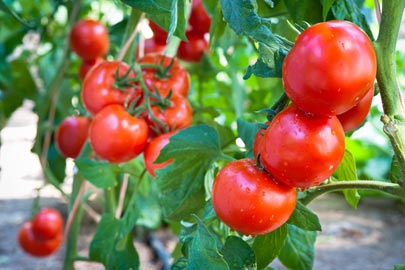 There is nothing quite like the taste of a sweet, juicy tomato plucked at the peak of ripeness.
There is nothing quite like the taste of a sweet, juicy tomato plucked at the peak of ripeness.
© Thinkstock
No garden veggie gives as much payback as a sweet, juicy tomato plucked at the peak of ripeness. Tomatoes are well worth a try—do enough things right and you’ll head off most threats. Start by picking a sunny spot, ideally with all-day sun. Those fruits need lots of light to form and mature. Before planting, improve your soil by loosening it to a foot deep and at least 2 to 3 feet around. Then mix in a bucket of compost, rotted leaves, peat moss or similar organic matter. You’ll end up with slightly raised beds of “fluffier” soil that encourage good root growth and drainage.
No sunny spot to dig up? Get a big pot, fill it with bagged potting mix, and grow your tomato on a deck or patio.
Which tomato you pick also makes a big difference. Not only do you get a choice of small cherry types, huge red round ones, plum-shaped paste types and more, but each type has many named variations. Sometimes the difference is in fruit color or plant size, but important differences also show up in bug- or disease-resistance, growth vigor and taste.
Have fun experimenting with different ones, but to get you started, try these:
Cherry types: Sungold, Sweet 100, Christmas Grapes, Sweet Million, Juliet.
Paste types: Amish Paste, Roma, Viva Italia, Plum Dandy.
Reliable red hybrids: Big Beef, Better Boy, Celebrity, Big Boy, Supersonic.
Great-tasting big, old-fashioned “heirlooms:” Mortgage Lifter, Cherokee Purple, Brandywine, Black Krim, Red Belgium, German Yellow.
 This cage supported by metal stakes keeps a tomato plant upright and the fruit from flopping on the ground.
This cage supported by metal stakes keeps a tomato plant upright and the fruit from flopping on the ground.
© George Weigel
When you’re ready to get started, don’t plant too early in the season. Tomatoes will die if a frost comes along after they’re in the ground. Mid to late April is usually “safe” in southern states; early to mid-May is prime planting time in the Midwest and Mid-Atlantic, and late May is better in the North.
You will want to keep the soil consistently damp all summer. That means soaking the ground around the plants at least two to three times a week. In pots, you’ll probably have to water daily. Use your finger to test for dryness.
Tomatoes are “heavy feeders” that appreciate fertilizer every four to six weeks throughout summer (weekly in pots). Choose one formulated specifically for tomatoes.
Be sure to stake or cage your plants to keep them from flopping over, and protect them with fencing if deer, groundhogs, squirrels or other tomato-loving critters lurk nearby. If you’ve ever tasted a home-grown tomato vs. a typical one sold at the grocery store, you’ll understand the passion for trying to grow your own.